|
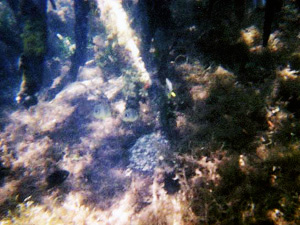
| 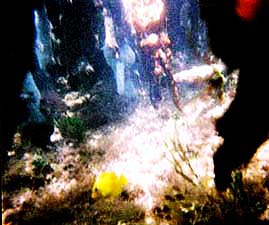 Underwater mangrove forests: The next four pictures were taken among the underwater prop roots and drop roots (structures extending down from the branches) of a Red Mangrove stand in the BVI. In the first picture (left) three juvenile four-spot butterflyfish ( Chaetodon capistratus ) can be seen swimming among sponge and algae encrusted mangrove roots. The second picture displays a juvenile Blue Tang ( Acanthurus coeruleus ) in the foreground and sponge encrusted drop roots in the background.
Underwater mangrove forests: The next four pictures were taken among the underwater prop roots and drop roots (structures extending down from the branches) of a Red Mangrove stand in the BVI. In the first picture (left) three juvenile four-spot butterflyfish ( Chaetodon capistratus ) can be seen swimming among sponge and algae encrusted mangrove roots. The second picture displays a juvenile Blue Tang ( Acanthurus coeruleus ) in the foreground and sponge encrusted drop roots in the background.
| 
| 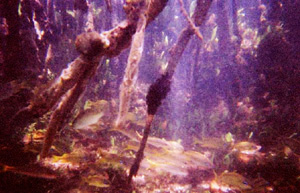 Underwater mangrove forests: The picture on the left shows a small schoolmaster snapper ( Lutjanus apodus ) swimming in the forgeround. On the right, a mixed school of grunts, goatfish, and snappers finds cover among drop roots enrusted with tunicates, sponges, and algae.
Underwater mangrove forests: The picture on the left shows a small schoolmaster snapper ( Lutjanus apodus ) swimming in the forgeround. On the right, a mixed school of grunts, goatfish, and snappers finds cover among drop roots enrusted with tunicates, sponges, and algae.
| 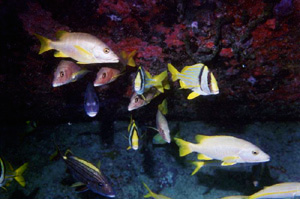
| 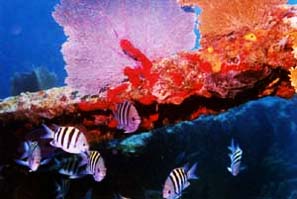 Coral Reef: The picture on the left includes adult Porkfish ( Anisotremus virginicus ), Schoolmaster Snapper, and Spanish Grunt (Haemulon macrostomum ). The picture on the right shows adult Seargent Majors ( Abudefduf saxatilis ) near a wreck covered with sponges and sea fans (Genus Gorgonia) . Juveniles of the fish species shown in these pictures grow in the mangroves before eventually settling in the reef system. Mangroves provide juvenile fish with food and protection from predators. These pictures were taken off Key Largo, Florida (USA).
Coral Reef: The picture on the left includes adult Porkfish ( Anisotremus virginicus ), Schoolmaster Snapper, and Spanish Grunt (Haemulon macrostomum ). The picture on the right shows adult Seargent Majors ( Abudefduf saxatilis ) near a wreck covered with sponges and sea fans (Genus Gorgonia) . Juveniles of the fish species shown in these pictures grow in the mangroves before eventually settling in the reef system. Mangroves provide juvenile fish with food and protection from predators. These pictures were taken off Key Largo, Florida (USA).
| 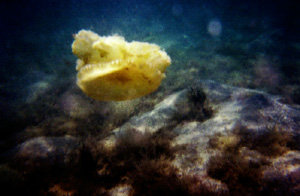 Upside Down Jellyfish (Genus Cassiopeia): Jellyfish belonging to this genus are commonly found in the water ways adjacent to mangrove stands. These cnidarians swim while upside down and commonly rest on the sea floor in shallow water. These jellyfish have a symbiotic relationship with the photosynthetic yellow green algae called zooxanthellae. This picture was taken in the BVI.
Return to top of page
Go to definitions
Go to mangrove species
Return to Mangrove Learning Center
All pictures taken by David Cabrera
Upside Down Jellyfish (Genus Cassiopeia): Jellyfish belonging to this genus are commonly found in the water ways adjacent to mangrove stands. These cnidarians swim while upside down and commonly rest on the sea floor in shallow water. These jellyfish have a symbiotic relationship with the photosynthetic yellow green algae called zooxanthellae. This picture was taken in the BVI.
Return to top of page
Go to definitions
Go to mangrove species
Return to Mangrove Learning Center
All pictures taken by David Cabrera
|


 Underwater mangrove forests: The next four pictures were taken among the underwater prop roots and drop roots (structures extending down from the branches) of a Red Mangrove stand in the BVI. In the first picture (left) three juvenile four-spot butterflyfish ( Chaetodon capistratus ) can be seen swimming among sponge and algae encrusted mangrove roots. The second picture displays a juvenile Blue Tang ( Acanthurus coeruleus ) in the foreground and sponge encrusted drop roots in the background.
Underwater mangrove forests: The next four pictures were taken among the underwater prop roots and drop roots (structures extending down from the branches) of a Red Mangrove stand in the BVI. In the first picture (left) three juvenile four-spot butterflyfish ( Chaetodon capistratus ) can be seen swimming among sponge and algae encrusted mangrove roots. The second picture displays a juvenile Blue Tang ( Acanthurus coeruleus ) in the foreground and sponge encrusted drop roots in the background.

 Underwater mangrove forests: The picture on the left shows a small schoolmaster snapper ( Lutjanus apodus ) swimming in the forgeround. On the right, a mixed school of grunts, goatfish, and snappers finds cover among drop roots enrusted with tunicates, sponges, and algae.
Underwater mangrove forests: The picture on the left shows a small schoolmaster snapper ( Lutjanus apodus ) swimming in the forgeround. On the right, a mixed school of grunts, goatfish, and snappers finds cover among drop roots enrusted with tunicates, sponges, and algae.

 Coral Reef: The picture on the left includes adult Porkfish ( Anisotremus virginicus ), Schoolmaster Snapper, and Spanish Grunt (Haemulon macrostomum ). The picture on the right shows adult Seargent Majors ( Abudefduf saxatilis ) near a wreck covered with sponges and sea fans (Genus Gorgonia) . Juveniles of the fish species shown in these pictures grow in the mangroves before eventually settling in the reef system. Mangroves provide juvenile fish with food and protection from predators. These pictures were taken off Key Largo, Florida (USA).
Coral Reef: The picture on the left includes adult Porkfish ( Anisotremus virginicus ), Schoolmaster Snapper, and Spanish Grunt (Haemulon macrostomum ). The picture on the right shows adult Seargent Majors ( Abudefduf saxatilis ) near a wreck covered with sponges and sea fans (Genus Gorgonia) . Juveniles of the fish species shown in these pictures grow in the mangroves before eventually settling in the reef system. Mangroves provide juvenile fish with food and protection from predators. These pictures were taken off Key Largo, Florida (USA).
 Upside Down Jellyfish (Genus Cassiopeia): Jellyfish belonging to this genus are commonly found in the water ways adjacent to mangrove stands. These cnidarians swim while upside down and commonly rest on the sea floor in shallow water. These jellyfish have a symbiotic relationship with the photosynthetic yellow green algae called zooxanthellae. This picture was taken in the BVI.
Upside Down Jellyfish (Genus Cassiopeia): Jellyfish belonging to this genus are commonly found in the water ways adjacent to mangrove stands. These cnidarians swim while upside down and commonly rest on the sea floor in shallow water. These jellyfish have a symbiotic relationship with the photosynthetic yellow green algae called zooxanthellae. This picture was taken in the BVI.